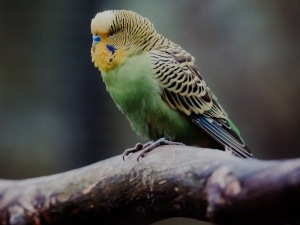
The beak is a very important part of a budgie’s anatomy, if there is something wrong with your budgie’s beak then this can keep the bird from eating.
So, keeping an eye on the beak is a must, especially if there is a change in the beak.
This article is a look into why your budgie’s beak is crusty.
Table of Contents
My budgie’s beak is crusty:
If your budgie develops a change in the beak this should not be overlooked, whether this is a beak deformity, a cracked beak, or crust developing on the beak.
Here is why your bird’s beak has suddenly developed a crust on it.
Food:
The simplest explanation for why your bird’s beak is crusty is that the bird has pieces of food stuck to the beak and the bird hasn’t taken it off yet.
A variety of different foods can stick to your bird’s beak, if the bird doesn’t wipe this food off right after eating then the food will dry up and look crusty.
What to do:
Dampen the crusty part of the bird’s beak and gently rub the area to see if the crust is actually food.
If it is food then it will easily be wiped off once dampened. If you wipe the area and the crust doesn’t go away then it may be something else:
Fungal infection:
Another reason why your bird may have a crusty beak is that it has a fungal infection.
Fungal infections will develop at the corners of the bird’s beak and will look like a small round ball the size of a millet seed, the fungal infection will attach to where the bird’s top and bottom beak join together.
This fungal infection cannot be removed by simply wiping it off, in fact, if you try to remove it by pulling it off then the area can bleed as this fungus is rooted in the bird’s skin.
What to do:
It is recommended that you take your bird to the vet to be examined and treated. It is also said that swabbing the area using diluted apple cider vinegar for 2-3 days will kill the yeast and it will fall off.
Scaly face mites:
One reason why your bird may develop a crusty beak may be that the bird has scaly face mites.
Mites can affect budgies all over their bodies and scaly face mites can make the bird’s beak develop a crust.
These mites are tiny microscopic bugs that dig and create tunnels in your bird’s beak, the birds will leave a thick scaly residue as they dig and travel all over your bird’s beak.
The crust can also develop around the outside of the bird’s mouth and a bird suffering from this condition can also develop feather loss at its beak and eyes.
What to do:
You can try to treat this condition at home but the more recommended solution is to take your bird to the vet to be examined and treated
The treatments for this condition can take a while to fully rid your bird of its mites, 6-8 weeks is a normal amount of time for mite treatments to work.
Also, when treating your bird’s condition, it is recommended that you keep healthy birds away from the infected bird as this condition is very contagious.
The quicker you treat your bird of this condition the better. If you don’t treat your bird then the mites will dig deeper into the bird’s beak reaching the face.
Once the mites reach the face they can start to attack the bird’s cere and eyelids.
If the mites attack the bird’s beak, the beak can become so damaged that the bird will lose its ability to eat and will eventually starve to death.
If you enjoyed this article then you may also be interested in other bird related articles. Here are some articles that you may be interested in: Why Do Birds Rub Their Beaks On The Fence, Why Does My Sun Conure Click His Beak, Why Do Birds Drag Their Beaks, Why Is My Love Bird’s Beak Turning Black?, Why Is My Parrot Beak Turning Black?, Baby Lovebird Beak Black

